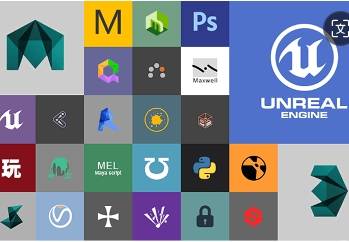Release date:2022, May
Author:BIM it! AEC
Skill level:Beginner
Language:English
Exercise files:Yes
What Will I Learn?
2D to 3D model creation MEP coordination by finding the clashes and solving them Extract the coordinated shop drawings and builders work Prepare the builders work by using dynamo Schedules and material take off extraction MEP Progress MonitoringRequirements
Be able to read MEP drawings
Need to install a trial of Autodesk Revit 2017 or later versions up to Revit 2023
1.3.4 dynamo or later versionsDescription All Revit versions from Revit 2017 to Revit 2023 are almost the same with some additional minor features for the later versions, but you can apply the BIM concept and follow up the course lectures using any version, from Revit 2017 up to Revit 2023.
In this course students will be familiar with the BIM services needed for the contractor to execute the mechanical, electrical and plumbing works on site with less time and less cost by providing the construction site with the coordinated shop drawings and exact material take off reports. So first we will learn the Revit basics of how to start a new project, setting up templates, linking the architectural model and the designed drawings into our live model and creating views and levels, then we will learn how to read and convert the designer MEP drawings into 3D models and all the tips, tricks and shortcuts needed to perform the work faster, then we will go through the coordination process by finding the clashes and solving them. Then we will use dynamo to create the builders works, then we will extract the shop drawings and the builder works from the coordinated model and we will learn how to create schedules for the MEP categories and finally we will reflect the site progress on the MEP model then we will extract progress monitoring report for all MEP elements. This course is aimed at complete beginners who have never used Revit before and want to increase their career options by learning Revit MEP. The ideal students for this course are the mechanical engineers, electrical engineers, BIM engineers, BIM drafters.
Who is the target audience?
MEP Engineers
BIM Engineers
MEP Draftsmen
Anyone who wants to learn 3D MEP modeling01 – Introduction Applying Revit to the world of mechanical, electrical, and piping
02 – 1. Starting a Revit Project01 – Starting a project using Revit templates 02 – Touring the user interface 03 – Linking other models 04 – Adding spaces 05 – Copying levels and setting up monitoring 06 – Creating floor plans
03 – 2. Revit Electrical01 – Adding receptacles 02 – Adding panels 03 – Creating a circuit 04 – Panel schedules 05 – Adding lighting fixtures 06 – Adding switches 07 – Creating a lighting circuit 08 – Creating a switching circuit 09 – Creating and labeling a wiring plan 10 – Adding conduit 11 – Creating conduit types 12 – Adding cable tray 13 – Large distribution
04 – 3. Revit Mechanical01 – Adding mechanical equipment 02 – Adding air terminals 03 – Adding supply duct 04 – Adding return duct 05 – Adding duct accessories and fittings 06 – Sizing duct 07 – Tagging duct 08 – Adding insulation
05 – 4. Revit Plumbing01 – Setting up a plumbing view 02 – Adding fixtures, components, and domestic supply piping 03 – Refining piping settings 04 – Creating routing preferences 05 – Adding sanitary sloped piping 06 – Adding vent piping 07 – Manipulating and creating filters 08 – Adding equipment 09 – Creating a system 10 – Adding pipe accessories 11 – Tagging items
06 – 5. Revit Workflow01 – Creating drafting views 02 – Importing AutoCAD 03 – Importing details 04 – Creating sheets 05 – Exporting to PDF 06 – Creating schedules 07 – Using phasing 08 – Working with text 09 – Working with dimensions 10 – Looking at mechanical settings 11 – Simple modify techniques 12 – Making and controlling revisions
07 – 6. MEP Fabrication Parts01 – Optimization of fabrication parts 02 – Adding fabrication parts manually 03 – Adding duct and pipe hangers 04 – Tagging fabrication parts 05 – Scheduling fabrication parts 06 – Multi-point routing for fabrication parts 07 – Adding a fully defined system to fabrication parts
08 – 7. System Browser01 – Creating an analytical air system 02 – Creating an analytical system zone 03 – Setting up an energy model 04 – Analyzing an HVAC system 05 – Analyzing an annual load report 06 – Generating an Insight analytical model
09 – ConclusionEx_Files_Revit_2023_EssT_for_MEP.7z [Udemy] Revit 2023 – Essential Training for MEP_Subtitles.7z
 Channel and
Channel and  Group
Group
1、登录后,打赏30元成为VIP会员,全站资源免费获取!
2、资源默认为百度网盘链接,请用浏览器打开输入提取码不要有多余空格,如无法获取 请联系微信 yunqiaonet 补发。
3、分卷压缩包资源 需全部下载后解压第一个压缩包即可,下载过程不要强制中断 建议用winrar解压或360解压缩软件解压!
4、云桥网络平台所发布资源仅供用户自学自用,用户需以学习为目的,按需下载,严禁批量采集搬运共享资源等行为,望知悉!!!
5、云桥网络-CG数字艺术学习与资源分享平台,感谢您的赞赏与支持!平台所收取打赏费用仅作为平台服务器租赁及人员维护资金 费用不为素材本身费用,望理解知悉!



评论(0)